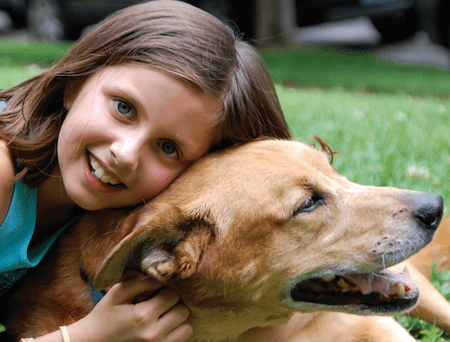Preventing Dog Bites in Children
How do we keep dogs and children safe together?
According to the Centers for Disease Control, approximately 800,000 people require medical attention for dog bites each year. Of those victims, children are bitten at a rate almost twice that of adults. For this reason, as both a veterinarian and a mother, I often cringe at those “cute” photos and videos on social media, depicting young children hobnobbing with dogs. While I hate to be a “Debbie Downer,” these photos too often depict children in potentially compromised positions, and in the eyes of a trained professional, are bites waiting to happen.
You might think to yourself “But my dog would never bite my child! My dog is safe, and my child is so gentle with Fluffy.” Others may think “I would never leave my child unsupervised with a dog.” You may be surprised then to learn children under t 7 are most likely to be bitten by the family pet or dogs they know, most often occur under the direct supervision of a parent or grandparent,

and are often triggered by positive interactions initiated by the child, such as reaching, hugging, kissing or petting. “How can this be?” you might ask. Well, to answer that question, we must ask why dogs show aggression to children in the first place.
Why do dogs bite children?
Family dogs most commonly bite young children in the context of resource guarding (e.g. sleeping areas, toys, food, etc.), or pain, as well as if they are stressed, scared or have been startled. Children sound, move and interact differently than adults. From a dog’s perspective, normal child behavior, loud and unpredictable it may sometimes be, can feel scary. Children can often, through no fault of their own, behave inappropriately around a dog, pulling a tail, tugging on an ear, attempting to sit on them, hugging them (fun fact: most dogs don’t enjoy being hugged), or disturbing them when they are sleeping. While many dogs will tolerate these interactions, no dog, I don’t care what the breed or history, is 100% safe around a child. Given a perfect storm of circumstances, the nicest dog in the world is going to act, well, “like a dog,” and will bite if all other signals they give us are being ignored.
What can we do to prevent dog bites?
I frequently hear parents say a dog bit “without warning.” In reality, dogs speak dog [body] language, and people speak people language. Dogs will almost always exhibit warning signs before biting, but parents and guardians need to know what to look for. Recognizing the signs, and intervening early, is an important key to prevention. While we can all recognize growling as a warning sign, three other common and easy to see canine stress signals are: lip smacking outside of the context of eating food, yawning outside of the context of waking up, and showing a half-moon or “whale” eye, where you see the whites at the outer edges of a dog’s eyes. Additional, perhaps more subtle signs of stress can include avoidance behaviors (turning away or moving away from a child), wagging a stiff tail, lowering the head, and stiff or tense body language in general (“I feel relaxed and good” canine body language is loose and wiggly). It’s also important to note that dogs may actually lick at a child as a sign of displacement stress. While this looks adorable to the uneducated observer, it can actually indicate conflict and a wish for the child to go away.
Watching for inappropriate human behavior is another important key to prevention. Young children in particular may not make safe decisions in regards to their behavior around dogs. Intervene if you see your child attempt to pet, lie on, or otherwise disturb a sleeping dog, corner or crawl under furniture to get to a dog, attempt to take a toy away from a dog, or disturb a dog when it’s eating. Hugging, kissing, tugging on tails or ears, lifting or pulling at jowels, are also all behaviors that risk instigating a bite.
Does that mean people with infants or toddlers or young children shouldn’t have pets?
Absolutely not! Growing up with a dog has countless wonderful benefits for children. Dogs teach empathy and responsibility, encourage physical activity, and are source of love, loyalty, comfort and affection, just to name a few examples! However, the safety and well being of both our children and our dogs should always be our top priority, and that requires an understanding of both dog behavior and risk factors for bites, so that unsafe interactions can be interrupted or ideally avoided entirely.
Dr. Gabrielle Ravina’s, (DVM, CHPV) solo practice is Peaceful Paws Veterinary Hospice, and is dedicated to in-home end of life care. Prior to starting her business in 2015, she worked in both emergency and general practice in both Santa Cruz and Los Gatos since 1998.








